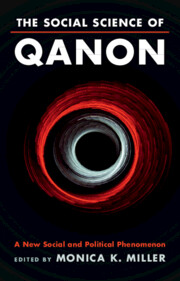Book contents
- The Social Science of QAnon
- The Social Science of QAnon
- Copyright page
- Dedication
- Contents
- Contributors
- Preface
- Part I Introduction to QAnon
- Part II Recruiting and Maintaining Followers
- Part III QAnon and Society
- Part IV The Role of Communication in Promoting and Limiting QAnon Support
- Chapter 12 QAnon and Social Media
- Chapter 13 Social Network Analysis Techniques Using NodeXL for Analyzing Disinformation Related to QAnon
- Chapter 14 QAnon, Folklore, and Conspiratorial Consensus
- Chapter 15 Debunking and Preventing Conspiracies
- Part V The Future of QAnon
- Index
- References
Chapter 14 - QAnon, Folklore, and Conspiratorial Consensus
A Case Study in the Computational Analysis of Conspiracy Theory Narratives
from Part IV - The Role of Communication in Promoting and Limiting QAnon Support
Published online by Cambridge University Press: 14 September 2023
- The Social Science of QAnon
- The Social Science of QAnon
- Copyright page
- Dedication
- Contents
- Contributors
- Preface
- Part I Introduction to QAnon
- Part II Recruiting and Maintaining Followers
- Part III QAnon and Society
- Part IV The Role of Communication in Promoting and Limiting QAnon Support
- Chapter 12 QAnon and Social Media
- Chapter 13 Social Network Analysis Techniques Using NodeXL for Analyzing Disinformation Related to QAnon
- Chapter 14 QAnon, Folklore, and Conspiratorial Consensus
- Chapter 15 Debunking and Preventing Conspiracies
- Part V The Future of QAnon
- Index
- References
Summary
QAnon, a conspiracy theory composed of a complex series of interlocking narratives detailing the machinations of malign actors whose seemingly insurmountable powers pose an existential threat to social order, is anchored in a folkloric process. It includes a wide range of characters from bad guys who kidnap, traffic, and cannibalize children, to good guys who rally “patriots” to fight elements of the “deep state.” We consider ~2 million discussion posts to social media forums where community members puzzle out the cryptic messages of the eponymous “Q.” Predicating our work on folklore theory, we apply a computational pipeline of AI methods to reveal the underlying narrative framework of the QAnon discussion forums, and identify the various links between otherwise largely unlinked domains of interaction and events that animate the conspiracy theory. We present a real-time user interface that allows users to monitor the changing topological features of the QAnon narrative framework.
Keywords
- Type
- Chapter
- Information
- The Social Science of QAnonA New Social and Political Phenomenon, pp. 234 - 251Publisher: Cambridge University PressPrint publication year: 2023



